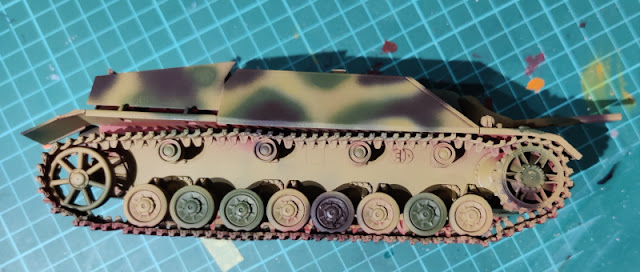Nineteenth session
Before I started painting the Balkenkreuz to my model, I spent a good moment searching for a nice simple list of which units actually had had Jagdpanzer IVs to begin with. Just to avoid making a completely ridiculous choice of using a unit that had never been assigned a tracked vehicle ("Hey, those crossed potato mashers could be fun, who're they?" -> "Oh crap, I am not doing a Dirlewanger vehicle, yuck!"), or something like that.
I was cross-referencing Wikipedia and Tanks-Encyclopedia about the usage of these vehicles, then I looked a the stencils I had, and the names of the divisions. From a couple of options I chose one semirandomly. My choice ended up being the 9th SSPzDiv Hohenstaufen, that also had in their organization a convenient unit, the 9th SS Tank Destroyer Batallion (I didn't think I had a stencil for subunits but I had to dobulecheck that later) that could give a home to my tank.
Why an SS unit? Their stencils were the easiest to find and recognize from my set.
There was a silly little challenge that I encountered with the Balkenkreuz stencils: I only had one of each size and type, and these tin cans usually had many of the same cross on them, I just couldn't take a production line approach, or I didn't dare to on my second attempt with them. So I did the full left one first, and a divisional marking to the left front corner.
As my white I used the fitting Insignia White (VMA 71279 Insignia White).
The whites of the Balkenkreuz looked good, the division mark was otherwise good but I had failed with the masking tape and there had been a tiny gap between the stencil and the tap, and there was a cursor-like line highly visible. Blast.
I aimed the black stencil onto place and taped it on.
And crap. I hadn't pressed my stencil tightly enough onto the model's surface and the black paint had flown over uglily. Fixing that at this point would be lots of fun™️. And I had managed to mismask and there was a similar ugly white line below the cross. Sigh.
Without letting that drag me down I repeated the stenciling-painting process on the right side of the tank.
And that worked out perfectly. Luckily something went the way I meant it to.
Speaking of that, what exactly was the problem with the left side of this model, as all the problems gathered there? I decided to take a break and repaint the failures again some other day. Now I was way too annoyed, and that, as I had learned, wasn't the mood for fixes.
A fixing round
After a couple of nights of sleep I returned to the paints. First of all I masked out the fixables. By the divisional marking I wanted to delete the white line, but obviously to protect the marking itself. On the left side I left a larger area open, so I could pretend I was keeping the camo pattern safe.
I started my fixing by airbrushing Dunkelgelb as multiple thin layers, blasting air only between each paint layer, until the ruined Balkenkreuz was hidden. Then I redid the green and brownish parts, and also repainted the front glacis plate's paintjob.
Redoing the left Balkenkreuz
I had misaligned my Balkenkreuzen vertically, the right one was noticably lower than the left one. Now that I was painting it anew, I also fixed my targeting somewhat. The painting order was obviously the same as before, now I just was much, much more paranoid with my masking tape application. Again I blew some air to help with the paint curing, unlike my more usual approach that has relied more on time itself.
Again the white edges worked perfectly, like in a book. Or should I talk about [video]tutorials these days instead? I was paranoid, like I said, with the black part and its masking tapes.
Funny thing, I didn't even think of being worried while detaching the masking tapes and the stencil(s). Somehow I was confident in my ability to do things correctly this time. And yes, this went really nicely this time. The camo pattern also behaved well enough.
I also painted quickly the now missing dots by hand, and added them around the vehicle now that I had a nicely tight-tipped brush in my hands.



















































